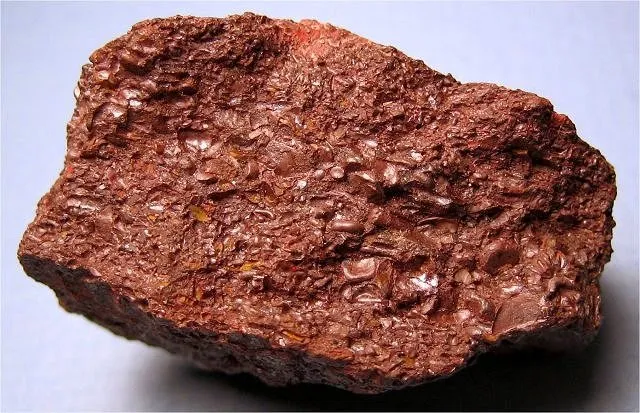
Appearance
Typically, iron ore is heavy, thick, and hard. Depending on the kind of iron oxide that is present, the color can change. Generally, hematite is red or reddish-brown, magnetite is black or dark gray, and goethite is brown or yellowish-brown. There are several different textures for iron ore, such as crystalline, granular, or massive.
Geographical Distribution
Australia, Brazil, China, India, Russia, and South Africa are the top producers of iron ore worldwide, making up the bulk of the world’s total production. Canada, Ukraine, the United States, Sweden, Iran, and Kazakhstan are a few more major producers of iron ore.
History
The majority of the iron ore resources on Earth are found in rocks that originated more than 1.8 billion years ago. Almost no dissolved oxygen and a large amount of dissolved iron were present in the oceans at that time. When the first animals capable of photosynthesis started releasing oxygen into the waters, iron ore deposits started to emerge.
Chemical Composition
The main component of iron ore is iron, which is typically found in the form of iron oxides as goethite (FeO(OH)), magnetite (Fe3O4), and hematite (Fe2O3). As impurities, it might also include silica, alumina, phosphorus, sulfur, and trace elements, among other components or minerals.

Types
Among the most common forms of iron ore deposits are the following:
Banded Iron Formation (BIF):
BIFs are sedimentary rocks with alternating bands of silica-rich minerals like chert and other iron-rich minerals like magnetite or hematite. The most important kind of iron ore deposit is called a BIF, and it is usually found in rocks that date back to the Precambrian. They are renowned for having high-grade iron ore content and can be rather large in size.
Magnetite Deposits:
Iron oxide minerals such as magnetite can be found in sedimentary, metamorphic, and igneous rocks. Magnetite deposits can occur as skarn deposits at the interface between intrusions and carbonate-rich rocks, and they are frequently linked to mafic and ultramafic intrusions. Because of their high iron concentration, magnetite deposits can be significant commercial sources of iron ore.
Hematite Deposits:
The iron oxide mineral hematite is extensively dispersed and can be found in a range of geological environments. Rocks that are sedimentary, igneous, or metamorphic can have hematite deposits. Although they can also exist as residual or enhanced deposits created by the weathering and erosion of iron-rich rocks, they are usually linked to BIFs. Even while hematite deposits frequently contain less iron than magnetite deposits, they can nevertheless be profitable sources of iron ore.
Goethite and Limonite Deposits:
Iron oxide minerals called goethite and limonite can form deposits known as laterites and are frequently linked to the weathering of rocks that are rich in iron. Typically, laterite deposits can be found in tropical and subtropical areas that have experienced heavy weathering. They are usually regarded as lower-grade iron ore deposits because of their high moisture content and low iron content.
Uses
The following are some of the main applications for iron ore and products:
- Steel production: Steel, one of the commodities that is used the most around the world, is made in large part from iron ore. Steel is utilized in many different industries, such as building, auto manufacture, appliances, machinery, and infrastructure for transportation.
- Construction: Buildings, bridges, roads, and other infrastructure are just a few of the construction projects that call for the utilization of iron and steel. Iron products are vital components in the construction industry because they give structures strength and longevity. Examples of these items are structural steel and reinforcing bars, or rebars.
- Manufacturing: Many different products, such as machinery, equipment, automobiles, appliances, tools, and consumer goods, are made using iron and steel. Because of their great strength and machinability, iron products are utilized in a variety of manufacturing processes, including casting, forging, and machining.
- Transportation: In the field of transportation, iron and steel are used to build automobiles, trucks, trains, and ships. The strength and structural integrity needed for the movement of people and commodities are provided by iron and steel.
- Energy production: Energy is produced using iron products, mainly in the form of electrical transformers and wind turbines. Electrical transformers employ iron cores for power distribution and transmission, whereas wind turbines use a lot of steel in their construction.
- Packaging and containers: Cans and other food and beverage containers are made from iron and steel. Steel and iron offer a strong and long-lasting barrier that keeps the items inside the packaging safe and of high quality.
- Defense and military applications: Applications for iron and steel in the military and defense sector include the construction of ships, armored vehicles, airplanes, and armaments. For these purposes, the necessary strength, toughness, and protection are offered by steel and iron.
- Art and decorative applications: Steel and iron are utilized to create sculptures, architectural accents, and furnishings, among other artistic and ornamental items. In artistic and decorative designs, iron and steel offer a distinctive aesthetic appeal and versatility.
Table





